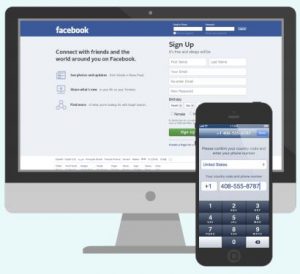Conversion rate optimization (CRO) is the method of using analytics and user feedback to improve the performance of your website. CRO can be used to improve any metric on your website that’s important to your business–often called key performance indicators (KPIs)–that you’re trying to improve, but it’s often associated with acquiring new customers, registrations, downloads, etc. Put another way, it increases the percentage of website visitors who experience the “aha moment” (or the must-have user experience) that turns passive browsers into valuable conversions.
At its most fundamental, CRO means figuring out what users are looking for when they arrive at your site and then giving that to them. CRO takes many different forms, based on the KPI you’re trying to improve. Sometimes this involves making your call-to-action more apparent or placing it on a traffic-heavy (but under-optimized) page. At other times this means removing or relocating unnecessarily complicated or time-consuming steps from your conversion funnel, as the added friction can prevent a conversion from ever happening.
Why Should You Care?
You should care about CRO for a few reasons. First, you are most likely paying for traffic to your site in one way or another, and a high conversion rate means a better return on that investment (ROI). It’s also much more cost-effective to convert a higher percentage of the visitors you already have than to attract more visitors. In addition to improving your ROI, optimization helps to defend against the limited attention span of your average visitor by giving them what they want before they tire of looking for it and move on.

CRO is important!
- Higher conversion rate = better ROI
- More cost effective than finding more visitors
- Defends against limited patience of visitors
It’s important to understand, however, that optimization is about getting more of the right kind of customers—not just blindly optimizing the conversion rate of a given page or campaign. It won’t do you any good if the people you’re acquiring are the wrong fit for your business. It’s important to keep the focus on optimizing to find more customers who will love your product and help you grow by spreading the word. Everything else is a waste of your time and resources.
The Basics of Conversion Rate Optimization
We defined conversion rate as the total number of conversions divided by the number of visitors to your site. But are we talking total visitors or unique visitors?
Think of it this way…
You operate a brick-and-mortar storefront and a customer comes in to check out one of your products. The clerk does a good job, and she seems pleased with the quality. She gets an important phone call, however, so she goes outside to take it. Or she forgets her wallet in her car. Or she goes to the shop down the street to see how their product compares.
She may eventually come back to your store and each time she does so counts as a single visit. If she stops in three times, she’s made three visits. She is of course, still the same person–one unique visitor making three visits back to the store.
This is similar to how people shop online

They sometimes look around a bit, they often get distracted, and they frequently check out the competition. And just like it wouldn’t make sense for a salesclerk in the above scenario to be reprimanded for not making a sale during each of the customer’s several visits, online stores shouldn’t expect to make a sale for each visitor represented by the total visitor count.
For this reason, many people choose to use unique visitors when determining their conversion rate. But whatever metric you ultimately decide on, consistency is key. It you decide total visitors gives a more accurate measure of your conversion rate, be sure to use it consistently or your trends will be off.
But there is a caveat: Currently uniqueness is measured by setting a persistent cookie, which isn’t perfect or always reliable.
You must also determine what time period you want to use in determining your conversion rate. Again, consistency is key here. Dividing a week’s unique visitors by the number of people who converted that week, and you’ve got that week’s (or day’s, or month’s) conversion rate. It’s not a good idea to add up daily unique visitors to make up a week or month.
Now that you know your current conversion rate, you can begin looking for barriers in your conversion funnel.
Identifying Barriers in Your Conversion Funnel
Conversion rate optimization is simply finding why visitors aren’t converting and fixing it. Rather than a series of guesses and hunches, CRO is a “process of diagnosis, hypothesis and testing.”
Any CRO strategy should begin with you putting yourself in your visitors’ shoes and looking closely at your site—specifically your conversion funnel. Where are the confusing or difficult points? These are the barriers standing in your visitors’ path to conversion.
Here are some areas you should take a look at:
- To start with, is your call to action clear and easy to find?
- Are your graphics relevant, well-placed, clean, and unique? Or are they distracting and overwhelming in number? Do you have a lot of unnecessary (or maybe misplaced or not-yet-necessary) text?
- Take a look at your site’s usability. Can users easily search your site for what they’re looking for? If you’re in e-commerce, is it easy to complete your checkout process? How many pages and clicks does it take to complete the key conversions you’re measuring? Is there a mobile version of your website? Keep your navigation, registration, contact, and payment uncluttered and easy to find and operate.
- Is it clear to your visitors that their security is your top priority? Is it easy to trust your site?
- Are your search engine optimization efforts up-to-date, accurate, and relevant? Are you using accurate titles, relevant keywords and proper meta data? Images should have correct names, and keywords should be used properly. Titles should be clear and descriptive. If these items are not relevant, people may be coming to your site looking for something you don’t offer, while those who seek your services are unable to find you.
- Do you have customer testimonials letting visitors know how happy others are with your services? Social proof is a powerful conversion rate driver.
Six Factors Drive Conversion Rate
For both types of conversions, your conversion rate hinges on six factors:
- Value proposition—This is the sum of all the costs and benefits of taking action. What is the overall perceived benefit in your customer’s mind? Those perceived costs and benefits make up your value proposition.
- Relevance—How closely does the content on your page match what your visitors are expecting to see? How closely does your value proposition match their needs?
- Clarity—How clear is your value proposition, main message, and call-to-action?
- Anxiety—Are there elements on your page (or missing from your page) that create uncertainty in your customer’s mind?
- Distraction—What is the first thing you see on the page? Does it help or hurt your main purpose? What does the page offer that is conflicting or off target?
- Urgency—Why should your visitors take action now? What incentives, offers, tone, and presentation will move them to action immediately?
But this list is by no means comprehensive, and what succeeds for one site might actually hurt the user experience (and therefore conversion rate) on another.
This is because each site has its own unique mission, strengths, and challenges. You may read reports of amazing success from changing button colors, but it’s important to realize that generalized tweaks like this don’t resolve more serious problems like the ones listed above.
Barriers in your conversion funnel will still exist, and there’s only so much you and your team can do to identify them. Ultimately, you will have to reach out to your users and ask them what about your site isn’t working.
P.S.—If you’d like to read more on this topic, please click here to download Qualaroo’s Guide to Conversion Rate Optimization in its entirety. And if learning more about CRO makes you want to improve your customer onboarding process, please click here to learn how to do exactly that.


 Verification
Verification 

